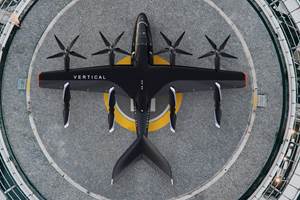Vertical performs piloted VX4 eVTOL flight in open airspace
Successful wingborne flight following approval from the UK Civil Aviation Authority (CAA) completes Phase 3 of Vertical’s path toward certification and commercial operation.
The VX4 prototype soars across the U.K. countryside from Cotswold Airport. Source | Vertical Aerospace
On May 27, Vertical Aerospace (London, U.K.) achieved piloted wingborne flight of a winged electric vertical takeoff and landing (eVTOL) aircraft in open airspace. The landmark flight of the VX4 prototype, piloted by chief test pilot Simon Davies, saw the aircraft takeoff, fly and land like a conventional aircraft, with lift generated by the wing.
Soaring across the U.K. countryside from Cotswold Airport, the VX4 prototype demonstrated controlled wingborne flight in open airspace for the first time, marking a critical step toward commercial deployment as part of Vertical’s Flightpath 2030 strategy.
Notably, the UK Civil Aviation Authority (CAA) approved the flight through open airspace at Cotswold Airport by extending Vertical’s Permit to Fly. This followed a rigorous review of tens of thousands of pages of safety and technical documentation.
“Our performance predictions were spot on, and the aircraft took off as a natural extension of all the ground tests and preparation we’ve done,” says Davies.
Vertical’s piloted winged eVTOL prototype has been developed under a design organization approval (DOA) from the CAA. A DOA is required to hold a type certificate, required for commercial passenger operations. The CAA is working closely with the European Union Aviation Safety Agency (EASA) for its concurrent validation and certifying the VX4 to the highest safety standards required for commercial use.
Vertical’s recent flight achievement has been supported by early U.K. government investment through programs including the Aerospace Technology Institute (ATI) and the Future Flight Challenge. These initiatives have contributed to the development of Vertical’s technology and flight test campaign, and form part of wider efforts to advance the U.K.’s net-zero and aerospace ambitions.
What is the significance of wingborne flight? During this Phase 3 testing, the VX4 aircraft operates like a conventional aircraft, using lift generated by its wings rather than relying solely on rotor thrust. This low-power, quiet and range-efficient mode of flight is key to making electric air travel practical, scalable and economically viable.
It also leads the company to its next milestone: a full piloted transition flight, expected in the second half of 2025. This will demonstrate the VX4’s ability to shift seamlessly between vertical lift and forward cruise — the operating mode it will use in passenger service.
During the wingborne flight phase, the VX4 will reach speeds of up to 150 miles per hour (120 knots) and altitudes close to 2,000 feet under real-world conditions. Engineers captured more than 30,000 in-flight data parameters, confirming the aircraft performed well across stability, control and energy use.
To prepare for piloted wingborne flights, Vertical has completed thousands of hours of lab, simulation and high speed ground testing, including:
- 7.2 million fatigue cycles on each propeller blade to simulate lifespan loads over the flight test campaign.
- 15.2-meter battery pack drop test, comparable to fuel-tank testing in traditional rotorcraft.
- Full-scale thermal runaway propagation test on a VX4 sub-pack, indicating safe flight and landing is possible even in the event of a battery fire.
- More than 3,000 hours of component and integration testing on flight control computers to ensure system reliability and performance.
Related Content
Joby demonstrator makes 523-mile hydrogen-electric flight
Hydrogen-electric program builds on technology developed by H2FLY subsidiary, demonstrates potential for emissions-free regional travel using Joby’s all-composite eVTOL aircraft.
Read MoreAirbus puts a pause on CityAirbus NextGen eVTOL program
Airbus Helicopters is hitting the breaks on program progress, citing that battery technologies need to evolve before it can launch a successful UAM program.
Read MoreVertical Aerospace eVTOL prototype goes down during uncrewed test flight
The U.K. company has confirmed the Aug. 9 accident that resulted in significant aircraft damage and potential setbacks.
Read MoreJoby flies two eVTOL aircraft simultaneously in testing milestone
The latest in the company’s flight testing program targets certification testing acceleration and support of its passenger-carrying goals by 2026.
Read MoreRead Next
Vertical Aerospace completes Phase 2 piloted flight testing
VX4 eVTOL aircraft prototype begins untethered, piloted, thrust-borne testing following expansion of permit to fly from the UK Civil Aviation Authority.
Read MoreJoby flies two eVTOL aircraft simultaneously in testing milestone
The latest in the company’s flight testing program targets certification testing acceleration and support of its passenger-carrying goals by 2026.
Read MoreArcher to provide Midnight eVTOL for 2028 Olympics, Paralympics
Archer seeks to integrate air taxi support across LA through transporting LA28’s VIPs, fans and stakeholders to key venues.
Read More


























